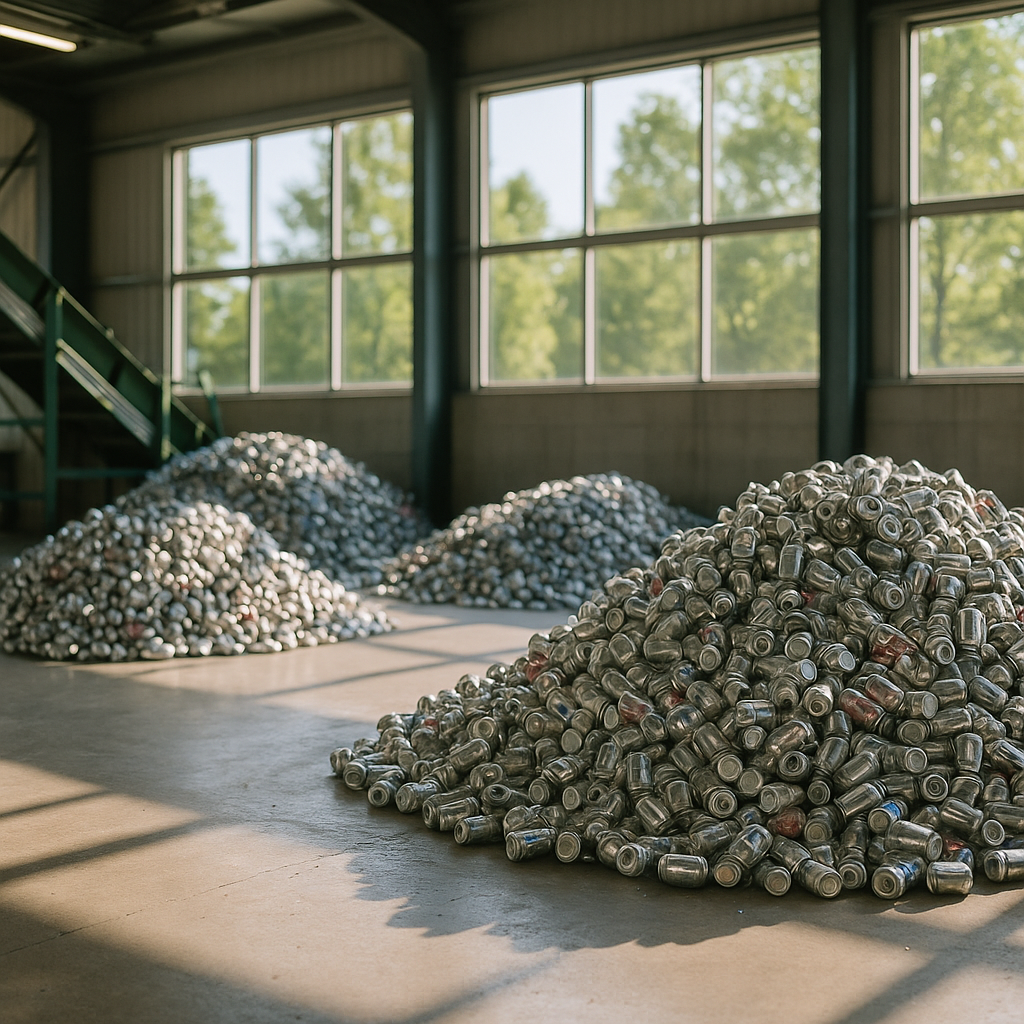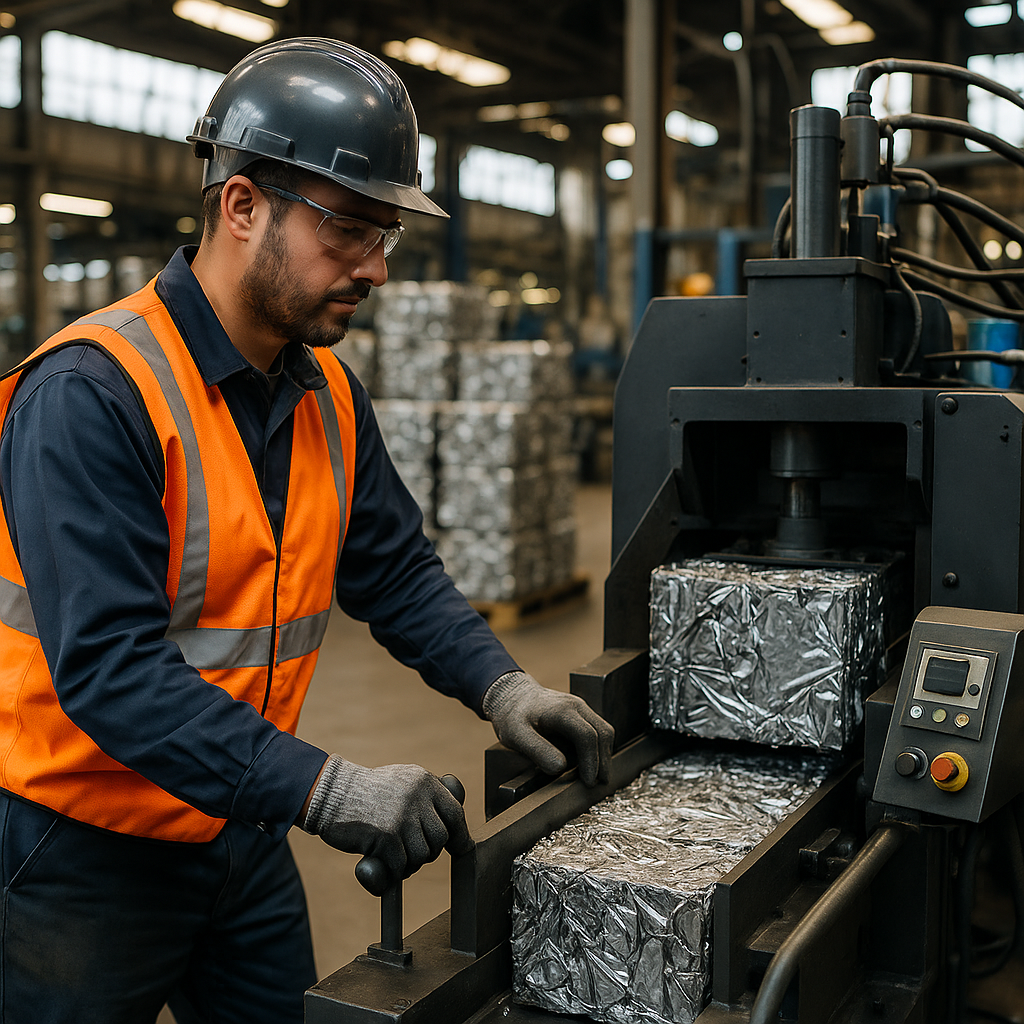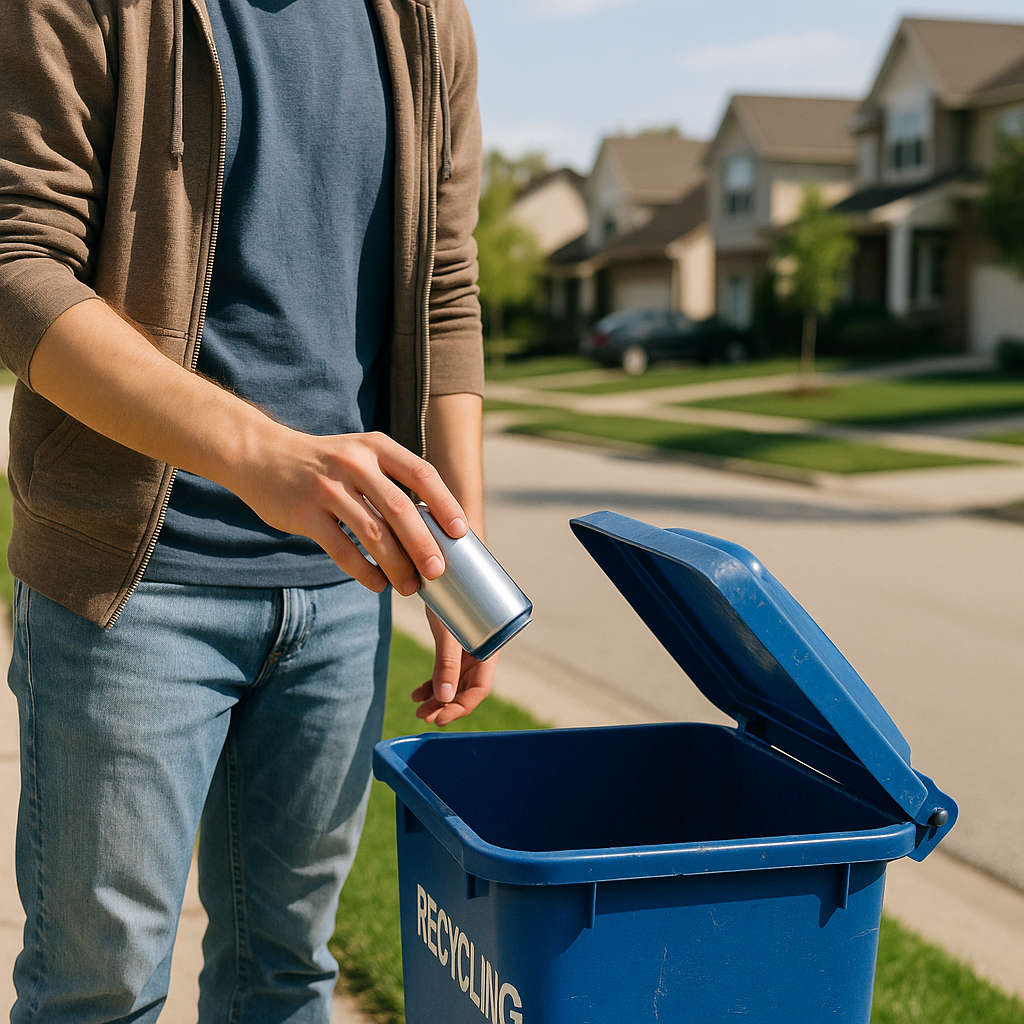5901 Botham Jean Blvd, Dallas, TX 75215
How Aluminum Recycling Powers Sustainability and Growth
August 19, 2025Did you know that recycling just one aluminum can saves enough energy to power a television for three hours? This remarkable efficiency makes aluminum recycling one of the most effective tools against waste and energy consumption. Aluminum recycling involves collecting used aluminum products, melting them down, and using the material to create new items without any loss in quality.
The significance of aluminum recycling cannot be overstated. Recycling aluminum uses only 5% of the energy required to produce new aluminum from raw bauxite ore. This impressive 95% energy savings directly translates to reduced greenhouse gas emissions, with recycling cutting CO₂ emissions by up to 95% compared to primary production. Notably, the energy saved by recycling a single ton of aluminum could power the average American home for more than 10 years.
In addition to energy savings, aluminum recycling significantly reduces waste and environmental impact. Aluminum can be recycled indefinitely without losing its properties, exemplifying a circular economy material. Nearly 75% of all aluminum ever produced is still in use today. By keeping this valuable resource in circulation instead of mining new raw materials, we conserve natural habitats, reduce landfill usage, and minimize the environmental damage caused by bauxite mining and processing.
What are the Environmental Benefits of Recycling Aluminum?

Recycling aluminum offers impressive environmental advantages that go beyond merely reducing waste. By recycling aluminum, greenhouse gas emissions are cut by up to 95% compared to producing new aluminum from raw bauxite ore, significantly aiding efforts to combat climate change.
The energy savings are just as noteworthy. Recycling aluminum uses only 5% of the energy required for primary production, resulting in substantial power conservation. The energy saved from recycling a single aluminum can is enough to power a television for three hours.
Habitat and Ecosystem Protection
Bauxite mining causes major disruptions to natural environments, often involving land clearing that leads to deforestation and habitat destruction. Recycling aluminum reduces the need for new bauxite mining, helping preserve biodiversity and natural ecosystems.
Open-pit bauxite mining is particularly damaging as it clears vast areas of vegetation, disrupts soil, and can cause erosion. Recycling aluminum helps mitigate these impacts by keeping existing aluminum in circulation.
The environmental benefits extend to water resources. Primary aluminum production creates nutrient-rich runoff that can encourage excessive algae growth in water bodies, disrupting aquatic ecosystems. Recycling aluminum reduces this pollution source.
Landfill Waste Reduction
Aluminum items can take centuries to decompose in landfills. Each ton of recycled aluminum saves about 10 cubic yards of landfill space, which is crucial as communities face limited waste disposal options.
Aluminum can be recycled indefinitely without quality loss. Unlike many materials that degrade during recycling, aluminum retains its properties no matter how many times it’s recycled, making it a cornerstone of sustainable manufacturing practices.
In the United States alone, the aluminum can recycling rate saves enough energy annually to power over 1.5 million homes for a year. Globally, these savings are even more significant.
Water Conservation and Pollution Prevention
Primary aluminum production is water-intensive and can lead to contamination issues. The bauxite refining process generates red mud, a highly alkaline waste product that threatens water sources if not managed properly.
Recycling aluminum significantly reduces water usage compared to primary production, a critical advantage as water scarcity issues grow worldwide.
The recycling process also prevents the release of perfluorocarbons (PFCs), potent greenhouse gases with atmospheric lifetimes of up to 50,000 years. These emissions reductions offer long-term environmental benefits.
Circular Economy Benefits
Aluminum exemplifies circular economy principles. Approximately 75% of all aluminum ever produced is still in use today, highlighting its value as a permanent material resource.
The efficiency of aluminum recycling is remarkable. A recycled aluminum can could return to store shelves as a new can in as little as 60 days, illustrating the speed and effectiveness of the aluminum recycling system.
Aluminum cans lead recycling rates among beverage containers, with an average recycled content of 73% — much higher than that of glass bottles (23%) or PET plastic bottles (3-10%).
These environmental benefits make aluminum recycling one of the most impactful sustainability actions for both industries and individuals. Each recycled can or aluminum product contributes to meaningful reductions in greenhouse gas emissions, habitat preservation, and pollution prevention.
How Does Aluminum Recycling Benefit the Economy?

Aluminum recycling is a significant economic force in the United States. The industry directly employs over 164,000 workers and indirectly supports an additional 535,000 jobs throughout the supply chain. These positions cover collection, processing, manufacturing, and research, offering diverse employment opportunities with substantial wages and benefits.
The economic impact goes beyond direct employment. For every job in the aluminum recycling industry, about 3.5 additional positions are supported in related sectors like transportation, retail, and services. This multiplier effect makes recycling facilities economic hubs for many communities, generating billions in economic output.
Local economies benefit significantly from aluminum’s high value in the recycling stream. Material recovery facilities (MRFs) heavily depend on revenue from aluminum cans to stay operational. According to the solid waste consulting firm Gershman, Brickner & Bratton, most MRFs in the United States would struggle to operate without the income from recycled aluminum beverage containers.
The financial flow to communities is considerable. The aluminum industry pays out nearly a billion dollars annually for recycled cans, providing crucial funding for community organizations, schools, and municipal recycling programs. This creates a virtuous economic cycle where environmental conservation supports community development.
The untapped economic potential is noteworthy. Currently, the United States recycles only about 45% of aluminum cans annually. A study by Ball Corporation found that increasing the recycling rate to 90% by 2030 could create approximately 104,000 new jobs, more than double industry wages from $2.1 billion to $5 billion and generate $1.6 billion in additional economic activity.
Resource efficiency represents another economic advantage. Aluminum recycling requires only about 10% of the capital investment compared to primary aluminum smelting. This efficiency helps maintain a viable manufacturing base while reducing dependence on imported materials. The aluminum recycling industry also contributes nearly $23 billion in federal, state, and local taxes when all supported employment is considered.
Secondary aluminum production (recycling) now accounts for more than 80% of U.S. aluminum production, compared to just 20-30% in the 1980s. This shift is especially important as primary aluminum production has declined in North America. Many recycling-focused sectors are experiencing significant growth, with jobs in secondary aluminum production increasing by 12.5% between 2022 and 2024 alone.
The economics of aluminum recycling present a strong business case. Recycled aluminum requires only 5% of the energy needed to produce new aluminum from bauxite ore, resulting in substantial cost savings for manufacturers. These savings can be passed along the supply chain, making aluminum products more economically competitive while simultaneously reducing environmental impact.
What Everyday Items Can Be Recycled?

Aluminum is one of the most recyclable materials available. Its distinct properties allow it to be recycled repeatedly without losing quality. Many common household items made from aluminum can be renewed through proper recycling.
Beverage cans are the most widely recycled aluminum product, with an impressive global recycling rate of about 69%. The process is remarkably efficient—an aluminum can can be recycled and returned to store shelves in just 60 days.
Apart from beverage cans, several other aluminum items from your home can be recycled. Food containers, pie pans, and baking sheets can all be processed into new aluminum products. Aluminum foil is also recyclable but requires proper preparation: it should be clean, free from food residue, and balled up before being placed in recycling bins.
Sheet aluminum from various household applications can be recycled as well. Window frames, gutters, and siding are valuable sources of recyclable aluminum, containing thicker grades that retain significant value in the recycling stream.
Even aluminum parts from vehicles and electronics can be recycled. Car components such as engine blocks, transmission cases, and wheels are recyclable. Electronics may contain aluminum enclosures and heat sinks that can be recovered and reprocessed.
For successful aluminum recycling, all items should be:
- Empty—free from remaining contents
- Clean—rinsed of food and other residues
- Dry—to prevent contamination of other recyclables
- Separated—removed from non-aluminum components when possible
The recycling process for aluminum is significantly more efficient than producing new aluminum from raw bauxite ore. Recycling aluminum saves about 95% of the energy required for primary production, making it both economically viable and environmentally beneficial.
At recycling facilities, aluminum items undergo sorting, shredding, cleaning, and melting. The molten aluminum is then formed into ingots for reuse in manufacturing new products. This closed-loop system enables the same aluminum atoms to be used repeatedly, reducing the need for energy-intensive mining operations.
By identifying and properly recycling these everyday aluminum items, you contribute to significant environmental benefits. Each ton of recycled aluminum prevents mining about four tons of bauxite ore and saves enough energy to power the average home for nearly a year.
How Can Individuals Contribute to Aluminum Recycling?

Individual actions are crucial to successful aluminum recycling programs. By engaging in consistent and thoughtful practices, each person can significantly impact the recycling process and contribute to resource conservation. Here are some effective ways individuals can support aluminum recycling efforts.
Daily Recycling Practices
Proper sorting is the first important step in recycling. By separating aluminum items from other materials, you prevent contamination that can compromise entire recycling batches. Rinsing your aluminum cans and containers thoroughly removes food residue and liquids, improving the quality of recyclables and reducing processing costs.
Collection methods are also important. Setting up dedicated recycling bins in convenient locations throughout your home makes regular recycling easier. When aluminum items are properly sorted at the source, recycling facilities can process them more efficiently, saving energy and reducing waste.
Beyond recycling cans, many other aluminum products are recyclable. Items like aluminum foil, baking trays, and packaging materials can be recycled but they must be clean and free of food residue. If unsure whether an aluminum item is recyclable, check with your local recycling center for guidelines.
Community Engagement and Education
Supporting local recycling programs is foundational for sustainable waste management in your community. Participate in community clean-up events specifically targeting aluminum and other recyclables. These initiatives not only remove waste from the environment but also help redirect valuable materials back into the recycling stream.
Education is key to expanding recycling efforts. Share information about aluminum recycling with friends, family, and colleagues. Many people are unaware of the significant environmental benefits of recycling aluminum or do not know which items can be recycled. By spreading awareness, you enhance your impact through the actions of others.
Consider organizing recycling drives at schools, workplaces, or community centers. These events can collect substantial amounts of aluminum while raising awareness about recycling benefits. They also provide opportunities to educate participants about proper recycling practices.
Consumer Choices and Deposit Programs
Making conscious purchasing decisions supports the broader aluminum recycling ecosystem. Whenever possible, choose products with high recycled content. This creates market demand for recycled materials and encourages manufacturers to use more recycled aluminum in their products. Reading labels and researching brands can help identify companies that prioritize recycled materials.
Many states have enacted container deposit laws, known as bottle bills, which involve a small refundable deposit on beverage containers. These programs typically charge an extra 5 to 10 cents per container at purchase, refundable upon returning the empty containers to collection points. States with deposit systems consistently show higher recycling rates than those without such incentives.
Participating in these deposit programs allows you to recover your deposit while ensuring the aluminum is recycled. Even if the financial incentive seems small, the collective environmental impact is substantial. In states with deposit systems, recycling rates for beverage containers often exceed 70%, compared to much lower rates in non-deposit states.
Workplace and School Initiatives
Extending recycling habits to workplaces and schools can extend your impact beyond the home. Advocate for comprehensive recycling programs at your workplace or school if they don’t already exist. Sometimes, just one dedicated person can drive positive change in organizational practices.
Suggest placing clearly labeled recycling bins in high-traffic areas like break rooms, cafeterias, and near vending machines. When recycling is convenient, participation increases significantly. You might also propose aluminum recycling drives as fundraising opportunities for schools or charitable organizations, offering both environmental and community benefits.
Remember, recycling one aluminum can saves enough energy to power a television for three hours. Multiplied across a workplace or school, these energy savings become significant.
Creative Reuse and Upcycling
Before recycling, consider whether aluminum items can be reused. Clean aluminum cans can serve various purposes, from organizing small items to starter garden seedlings. Aluminum foil can often be cleaned and reused multiple times before recycling. This approach maximizes the value of aluminum before it enters the recycling stream.
For those with a creative flair, upcycling is another option. Aluminum cans can be transformed into decorative items, jewelry, or functional household objects. While not a substitute for systematic recycling, these practices prolong the life of aluminum products and highlight resource conservation through visible, tangible examples.
Individual actions may seem small in isolation, but collectively they are powerful. Every properly recycled aluminum can or container contributes to substantial energy savings, reduced greenhouse gas emissions, and conservation of natural resources. By incorporating these practices into daily life, individuals become crucial participants in fostering a sustainable future through aluminum recycling.
Final Words
Aluminum recycling delivers powerful environmental, economic, and social benefits. From conserving 95% of the energy otherwise needed for primary production to creating thousands of jobs and reducing landfill waste, it stands out as one of the most effective sustainability practices available. Because aluminum can be recycled indefinitely without losing quality, every can, tray, or piece of scrap returned to the recycling stream supports a circular economy and helps protect natural ecosystems from the impacts of mining and pollution.
Ultimately, the success of aluminum recycling depends on widespread participation. Whether through daily household recycling, community programs, or choosing products with recycled content, individuals and industries alike have the power to close the loop and maximize aluminum’s value as a permanent resource.
Recycle your aluminum today to save energy, cut emissions, and protect our planet’s resources. Call Okon Recycling at 214-717-4083 to make a lasting impact.
